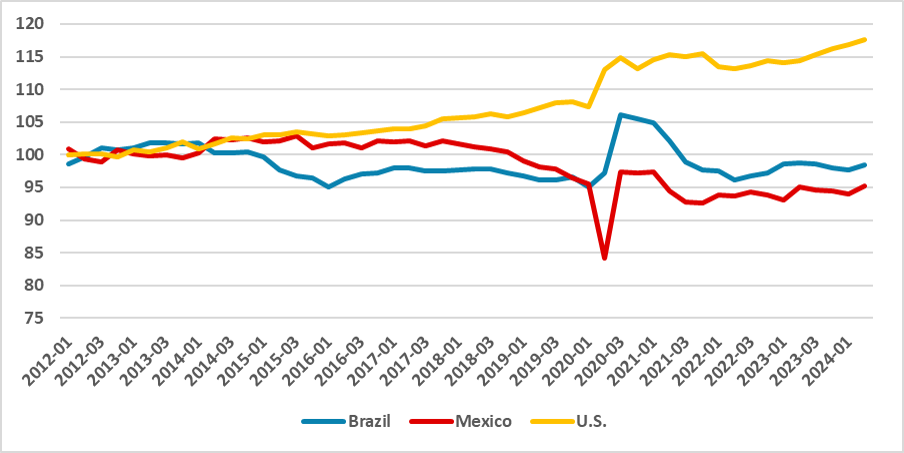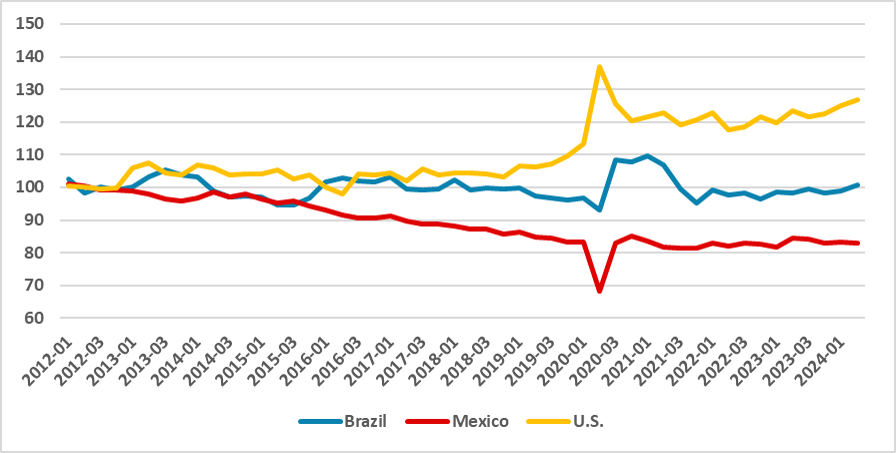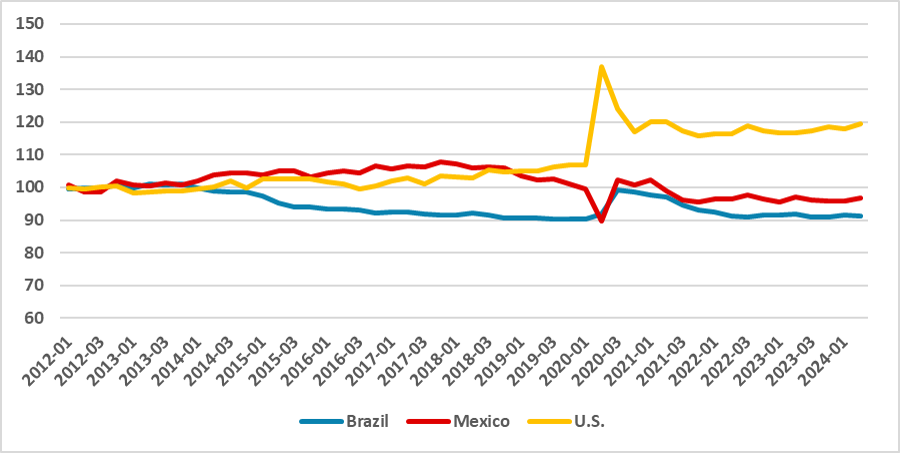Brazil and Mexico Labour Productivity: A Headwind for Growth
Brazil and Mexico labour productivity has been stagnant in the last years, with both countries registering lower labour productivity levels than they were 12 years ago, with the gap with U.S. only widening. With both countries approaching full-employment, measures will need to be taken to foster growth through productivity gains, otherwise both countries are doomed to come back to pre-pandemic trends in which they were registering growth below the 2% mark.
Figure 1: Labour Productivity (2012 = 100)

Source: Continuum Economics
We analyze the dynamics of labour productivity in Brazil and Mexico. Both countries have been experiencing unusually high growth figures. Before the pandemic, Brazil and Mexico were registering growth rates of around 2%. However, in 2023 and 2024, both are expected to surpass these growth levels. One key factor that could sustain this growth is an increase in labour productivity. If Brazilian and Mexican workers produce more consistently, once both economies reach full employment, growth could be sustained through higher levels of labour productivity.
Figure 2: Labour Productivity - Agriculture (2012 = 100)

Source: Continuum Economics
Unfortunately, this is not the trend observed in Brazil and Mexico. Labour productivity in these countries has stagnated over the last 12 years. Compared to 2012, both countries now have labour productivity levels below those registered that year. Recent growth has been driven more by labour absorption—adding more workers to the economy—rather than by improvements in workers’ productivity. Consequently, the productivity gap with the United States has continued to widen.
Figure 3: Labour Productivity - Industry (2012 = 100)

Source: Continuum Economics
This is a concerning situation, as both countries are facing tighter labour markets. In Brazil, there is still some room for growth through labour absorption, given the unemployment rate of 6.8%. It is fair to say that Brazil's economy has not yet reached full employment. However, Mexico is clearly operating near full-employment levels, with an unemployment rate of around 2.8%, suggesting that further growth through labour absorption will be challenging in the coming years. One alternative for Mexico could be increasing female participation in the labour market, which remains lower than that of its peers. Another one is the return of some immigrants in U.S. although it remains very uncertain.
Figure 4: Labour Productivity - Services (2012 = 100)
 Source: Continuum Economics
Source: Continuum Economics
Examining specific trends, we observe that labour productivity in both the services and industry sectors in Brazil and Mexico lags significantly behind that of the United States. Interestingly, U.S. services productivity appears to have benefitted from the post-pandemic, a phenomenon not observed in Brazil and Mexico. It is likely that service jobs created during this period were one of low quality, contrasting with the one created in U.S. A notable exception for Brazil has been the agriculture sector. Labour productivity in this sector has grown faster than the trends seen in both Mexico and the U.S., reflecting the adoption of state-of-the-art production techniques. Furthermore, Brazil’s agricultural sector has been highly competitive in international markets. Given the availability of arable land to expand agricultural production and the demand of populous countries for food such as China and India, this sector is likely to continue performing strongly. However, transforming overall labour productivity dynamics will remain a significant challenge.
In summary, productivity remains a major obstacle for sustained growth in both Brazil and Mexico. We expect both countries to return to growth rates below 2% in the coming years. This post-pandemic growth period likely reflects a delayed economic recovery in Mexico, while in Brazil, it is driven by fiscal stimulus in an economy with high levels of idle capacity. Structural reforms are essential to improve labour productivity in both countries and enable them to achieve higher, sustainable growth rates.